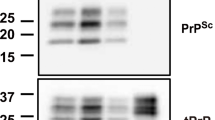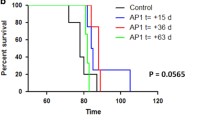Abstract
Pharmacological treatment with polyanions or amphotericin B in hamsters with experimental scrapie reveals that it is possible to delay the appearance of the disease only when the drug is given before the invasion of the agent into the clinical target areas of the brain. We suggest such early treatment may be possible for individuals at high risk of acquiring the disease, such as healthy mutation-positive relatives of patients with familial Creutzfeldt-Jakob disease or Gerstmann-Sträussler syndrome, or recipients of potentially contaminated pituitary-extracted human growth hormone.
Similar content being viewed by others
References
Billette de VillemeurT., BeauvaisP., GourmelenM. and RichardetJ.M. (1991): Creutzfeldt-Jakob disease in children treated with growth hormone. - Lancet, 337: 864–865.
BrownP. (1990): A therapeutic panorama of the spongiform encephalopathies. - Antiv. Chem. Chemother. 1: 75–83.
BrownP. (1990): Transmissible spongiform encephalopathies in humans: kuru, Creutzfeldt-Jakob disease and Gerstmann-Sträussler-Scheinker disease. - Can. J. Vet. Res. 54: 38–41.
BrownP., GajdusekD.C., GibbsC.J.Jr. and AsherD.M. (1985): Potential epidemic of Creutzfeldt-Jakob disease from human growth hormone therapy. - N. Engl. J. Med. 313: 728–731.
BrownP., GoldfarbL.G. and GajdusekD.C. (1991): The new biology of spongiform encephalopathy: infectious amyloidoses with a genetic twist. - Lancet 337: 1019–1022.
BuchananC.R., PreeceM.A. and MilnerR.D.G. (1991): Mortality, neoplasia, and Creutzfeldt-Jakob disease in patients treated with human pituitary growth hormone in the United Kingdom. - Br. Med. J. 302: 824–828.
BruceM. and DickinsonA.G. (1987): Biological evidence that scrapie agent has an independent genoma. - J. Gen. Virol. 68: 79–89.
CasacciaP., LadoganaA., XiY.G. and PocchiariM. (1989): Levels of infectivity in the blood through the incubation period of hamsters peripherally injected with scrapie. - Arch. Virol. 108: 145–149.
DickinsonA.G. (1976): Scrapie in sheep and goats In:Slow Virus Diseases of Animal and Man. R.H. Kimberlin. Ed., North Holland, Amsterdam, pp. 209–241.
DickinsonA.G. and FraserH. (1972): Scrapie: effect of Dh gene on incubation period of extraneurally injected agent. - Heredity 29: 91–93.
DickinsonA.G., MeikleY.M.H. and FraserH. (1968): Identification of a gene which controls the incubation periods of some strains of scrapie in mice.- J. Comp. Pathol. 78: 293–299.
DickinsonA.G. and OutramG.W. (1988): Genetic aspects of unconventional virus infections: the basis of the virino hypothesis. In: Novel Infectious Agents and the Central Nervous System, G. Bock and J. Marsh. Eds., John Wiley & Sons, Ciba Foundation Symposium No. 135, Chichester, pp. 63–77.
DiringerH. (1984): Sustained viremia in experimental hamster scrapie. - Arch. Virol. 82: 105–109.
DiringerH. and EhlersB. (1991): Chemoprophylaxis of scrapie in mice. - J. Gen. Virol. 72: 457–460.
EhlersB. and DiringerH. (1984): Dextran sulphate 500 delays and prevents mouse scrapie by impairment of agent replication in spleen. - J. Gen. Virol. 65: 1325–1330.
EhlersB., RudolphR. and DiringerH. (1984): The reticuloendothelial system in scrapie pathogenesis. -J. Gen. Virol. 65: 423–428.
FarquharC.F. and DickinsonA.G. (1986): Prolongation of scrapie incubation period by an injection of dextran sulphate 500 within the month before or after infection. - J. Gen. Virol. 67: 463–473.
FradkinJ.E., SchonbergL.B., MillsJ.L., GunnW.J., PiperJ.M., WysowskiD.K., ThomsonR., DurakoS. and BrownP. (1991): Creutzfeldt-Jakob disease in pituitary growth hormone recipients in the United States. - JAMA 265: 880–884.
FraserH. (1976): The pathology of natural and experimental scrapie. In: Slow Virus Diseases of Animal and Man. R.H. Kimberlin. Ed., North Holland, Amsterdam, pp. 267–305.
FraserH. and DickinsonA.G. (1970): Pathogenesis of scrapie in the mouse: the role of the spleen. Nature 226: 462–463.
FraserH. and DickinsonA.G. (1978): Studies of the lymphoreticular systems in the pathogenesis of scrapie: the role of spleen and thymus. - J. Comp. Pathol. 88: 563–573.
HadlowW.J., KennedyR.C. and RaceR.E. (1982): Natural infection of Suffolk sheep with scrapie virus.- J. Infect. Dis. 146: 657–664.
HadlowW.J., KennedyR.C., RaceR.E. and EklundC.M. (1980): Virologic and neurohistologic findings in dairy goats affected with natural scrapie. - Vet. Pathol. 17: 187–199.
HourriganJ.L., KlingspornA.L., ClarkW. W. and DeCampM.G. (1979): Epidemiology of scrapie in the United States. In: Slow Transmissible Diseases of the Nervous System. S.B. Prusiner and W.J. Hadlow. Eds., - Academic Press, New York, vol. 1, pp. 331–356.
KimberlinR.H., ColeS. and WalkerC.A. (1987): Pathogenesis of scrapie is faster when infection is intraspinal instead of intracerebral. - Microb. Pathogen. 2: 405–415.
KimberlinR.H. and WalkerC.A. (1977): Characteristics of a short incubation model of scrapie in the golden hamster. - J. Gen. Virol. 34: 295–304.
KimberlinR.H. and WalkerC.A. (1978): Pathogenesis of mouse scrapie: effect of route of inoculation on infectivity titres and dose-response curves. - J. Comp. Pathol. 88: 39–47.
KimberlinR.H. and WalkerC.A. (1983): Invasion of the CNS by scrapie agent and its spread to different parts of the brain. In: Virus non Conventionnels et Affections du Systeme Nerveux Central. L.A. Court and F. Cathala Eds., Masson, Paris, pp. 17–23.
KimberlinR.H. and WalkerC.A. (1983): The antiviral compound HPA-23 can prevent scrapie when administered at the time of infection. - Arch. Virol. 78: 9–18.
KimberlinR.H. and WalkerC.A. (1986): Suppression of scrapie infection in mice by heteropolyanion 23, dextran sulfate, and some other polyanions. -Antimicrob. Agents Chemother. 30: 409–413.
KimberlinR.H. and WalkerC.A. (1986): Pathogenesis of scrapie (strain 263K) in hamsters infected intracerebrally, intraperitoneally or intraocularly. J. Gen. Virol. 67: 255–263.
KimberlinR.H. and WalkerC.A. (1988): Pathogenesis of experimental scrapie. In: Novel Infectious Agents and the Central Nervous System, G. Bock and J. Marsh. Eds., John Wiley & Sons, Ciba Foundation Symposium No. 135, Chichester, pp. 37–54.
Ladogana A., Casaccia P., Ingrosso L., Cibati M., Salvatore M., Xi Y.G., Masullo C. and Pocchiari M.: Sulphate polyanions prolong the incubation period of scrapie-infected hamster. - J. Gen. Virol., submitted.
PocchiariM., SchmittingerS. and MasulloC. (1987): Amphotericin B delays the incubation period of scrapie in intracerebrally inoculated hamsters. - J. Gen. Virol. 68: 219–223.
PocchiariM., CasacciaP. and LadoganaA. (1989): Amphotericin B: a novel class of antiscrapie drugs. -J. Infect. Dis. 160: 795–802.
PocchiariM., MacchiG., PeanoS. and ConzA. (1988): Can potential hazard of Creutzfeldt-Jakob disease infectivity be reduced in the production of human growth hormone? Inactivation experiments with the 263K strain of scrapie. - Arch. Virol. 98: 131–135.
Pocchiari M., Peano S., Conz A., Eshkol A., Maillard F., Brown P., Gibbs CJ. Jr., Tenham-Fisher E. and Macchi G. (1991): Combination ultrafiltration and 6 M ureatreatment of human growth hormone effectively minimizes risk from potential Creutzfeldt-Jakob disease virus contamination. - Horm. Res., in press.
WilesmithJ. W., WellsG.A.H., CranwellM.P. and RyanJ.B.M. (1988): Bovine spongiform encephalopathy: epidemiological studies. - Vet. Rec. 123: 638–644.
Author information
Authors and Affiliations
Additional information
Corresponding author
Rights and permissions
About this article
Cite this article
Pocchiari, M., Salvatore, M., Ladogana, A. et al. Experimental drug treatment of scrapie: A pathogenetic basis for rationale therapeutics. Eur J Epidemiol 7, 556–561 (1991). https://doi.org/10.1007/BF00143139
Issue Date:
DOI: https://doi.org/10.1007/BF00143139




